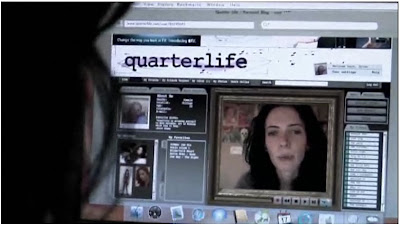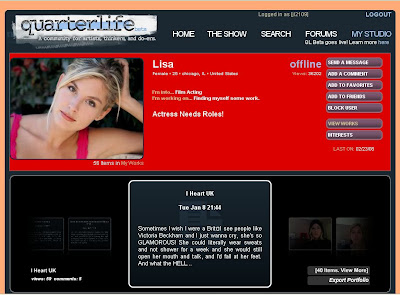Posted by Jay Livingston
A new television show starts tonight – Quarterlife. The show started on the Internet back in November. I didn’t hear about it until early this month and started watching because it was a Zwick/Herskovitz show. They are the guys who created thirtysomething, My So-Called Life (fifteensomething), and Once and Again (fortysomething). This time it’s twentysomething. I’ve seen thirty-two episodes. They’re short – about seven minutes each, not counting the credits.
The show was created as a hybrid. Quarterlife is not only the name of the show, it’s also a MySpace-like site that the characters use, posting their vlogs and sending vmail. But the creators of the show also made the site real, so that fans can use it in the same way the characters do.

During the writers’ strike, more people took to getting their fiction on the Internet, and the strike was based on the assumption that this trend would continue. I wonder how the format will affect the shows. Will shows created for the Internet be different? Will shows look different if they are shot for two-inch iPods as well as 52-inch Sonys? Will the content be different? So far the show seems to me not up to the level of Zwick and Herskovitz’s earlier shows. I think that’s because the seven-minute format forces them to use heavy-handed plot manipulations where an hour format (45 minutes) allows things to develop in ways that seem more “natural.”
Beyond content, there’s the McCluhan question: what is the message of this medium? Right now, you can go the Website and see vlog entries from the characters. Were these created specifically as Internet content, or are they “deleted scenes” from the show? It doesn’t really matter.
 More interestingly, you can also see vlog entries from fans that are indistinguishable from the fictional vlogs. You can read the blog entries of the characters, and apparently you can send them a message, “add to friends,” etc. I haven’t tried it. I haven’t been able to get into writing to fictional characters since I stopped sending letters to Santa. But then again, I’m like so twentieth century.
More interestingly, you can also see vlog entries from fans that are indistinguishable from the fictional vlogs. You can read the blog entries of the characters, and apparently you can send them a message, “add to friends,” etc. I haven’t tried it. I haven’t been able to get into writing to fictional characters since I stopped sending letters to Santa. But then again, I’m like so twentieth century.







